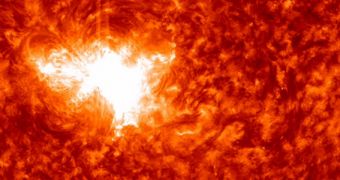Solar physicists operating the American space agency's Solar Dynamics Observatory (SDO) identified an M5.6-class solar flare on the surface of the Sun on Monday, July 2. The event originated in the sunspot AR1515, which experts have been monitoring for a while.
The event peaked at 6:52 am EDT (1052 GMT), experts at the NASA Goddard Space Flight Center (GSFC) explain. An M-class flare means a medium-sized eruption and the newest event is in line with the overall trend of increased solar activity.
By the middle of next year, the Sun will reach the period of maximal activity of its current, 11-year cycle. Over the next few years, the number of sunspots, solar flares and coronal mass ejections (CME) will begin to decrease as the star heads towards a new solar minimum.
Scientists with the GSFC Space Weather Center say that July 2 also saw the release of a CME, this time from a different spot. The event began at 4:36 am EDT (0836 GMT) and produced a cloud of highly charged particles traveling at a speed of around 700 miles (1,126 kilometers) per hour.

 14 DAY TRIAL //
14 DAY TRIAL //